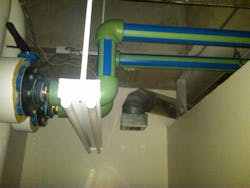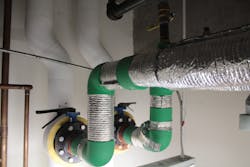PHOENIX — The Arizona Republic Building in downtown Phoenix is named after its most famous tenant, the Arizona Republic newspaper, the largest daily in the state, and 16th largest in the nation.
The newspaper business has changed a lot since 1890 when the Republic was founded. Gannett Media International purchased the paper in 2000, bringing it into common ownership with USA Today and the local NBC affiliate. Since then the paper has done more and more of its work — and made more and more of its revenue — on line; which has been good for the newspaper, but has been tough on the Arizona Republic Building.
Server explosion
“When we moved in there originally we had about 100 servers,” says Steve Holmquist, former facilities manager for the Arizona Republic Building. “When I left, we had about a thousand.” Gannett Media, hoping to save money through consolidation, brought in servers from both USA Today and from its Digital Realty Trust. “I built a system that had redundancy, and they ate up all my redundancy through growth.”
Redundancy — not just capacity — is key. If any part of the system breaks down, even if multiple parts of the system break down, there still needs to be enough cooling to keep the servers on-line. Because when the servers go down, money walks out the door.
When the time came to swap out some of the Trane chiller units on the roof, Holmquist needed to create a secondary loop to keep the system operating. After all the work was done he was left with a redundant chilled loop and thought, “Why not expand the cooling capacity and improve on the redundancies?” After all, it seemed a pretty sure bet the Republic was only going to add more servers.
Holmquist turned to Metal Masters Mechanical of Phoenix, the contractor that had already done most of the building’s HVAC work and had the general maintenance contract. Metal Masters had also been in on the earlier air handler change-out, so they were familiar with the system.
Meet Metal Masters
Metal Masters Mechanical is a third-generation, family-run business. Jay Faraci, Owner/Vice President works alongside his brother, sister, wife and brother-in-law in a business his grandfather started in the 1930s. They make it a point to treat their employees like family as well. “My shop foreman has been with us over 21 years,” Faraci says. “A lot of our guys have been with us over 10 years, and our turnover rate is very low.”
Metal Masters employs between 30 and 35 people, and is a full-service mechanical, plumbing and general contractor. They specialize in facility work, and are a vendor for such companies as Honeywell, Walmart and AT&T. They do full service welding and have their own fabrication shop.
But before the new system could even be designed a major question had to be answered: what kind of pipe to use?
Decisions, decisions…
As for copper, besides the expense, Faraci was hoping to avoid any prep-welding in the ceiling area. “There were a tremendous amount of fiber-optic cables in the area, a lot of fire hazard,” Faraci says.
The Climatherm pipe was ideal for use in tight spaces.
Holmquist was leery of copper for reasons of his own. He’d had a bad experience with a production facility that used copper pipe. “That facility is about 20 years old,” Holmquist explains, “and we’ve had nightmares with pinholes in copper. There’s been a number of articles written up about it, but nobody really knows if it’s impurities in the original fabrication of the pipe or what.”
As for steel, arc welding would have presented the same fire hazard. Even if it didn’t cause a fire it might set off smoke detectors which, in a large office building, is the last thing anyone wants. Also, the tight confines of the installation — ceiling area just 24 inches high — would have made it difficult to work with.
Steel pipe also “Would have involved cutting and threading, shutting down large sections of the floor,” Faraci says.
In the end, Holmquist decided to go with Climatherm, a polypropylene pipe from Aquatherm. The pipe is non-metallic, making it lighter and easier to handle than steel. But since he had never used the product before, Holmquist decided to run it through his own rigorous battery of stress tests.
The main heat pump connection.
“I brought some samples down into the shop,” Holmquist says, “and subjected it to all sorts of tests. I hit it with a sledgehammer, heated it with a torch and all that. I couldn’t hurt it in the shop, so we tried it.”
Installation
It was also the first time using PP-R pipe in an installation for Metal Masters. Luckily, training was available through their supplier, Sustainable Building Products.
“Marty Hayes was the rep who came out and actually did hands-on training with about eight of us,” Faraci says. “Spent a couple hours, gave everyone plenty of attention. It was only about two weeks later we did the actual job.”
The installation ran four, 3-in. lines branched from a 4-in. main source line through the 24-in. ceiling area. “Installing the 3-in. main lines in some of the tight spots was a bit challenging,” Faraci says, “but it was still a better option than steel.”
The 3-in. pipe was covered with a ½-in. plenum insulation. “The Climatherm does not require insulation because it doesn’t sweat,” explains Holmquist, “but because we’re running in a plenum we had to use plenum wrap insulation, mainly to protect the pipe in the event of a building fire.”
Joining system
The completed installation used approximately 300 linear feet of pipe in total. Climatherm is joined using heat fusion, which partially melts the pipe and fitting together in a monolithic bond.
That bond is formed by a fusion welder. “It’s kind of like a little box machine that wraps around the joint,” explains Holmquist. “It works off 120 v. power. Kind of like CPVC, but instead of having a wire embedded in the coupling they just use exothermic heat to bring the outside in and weld the joint together.”
The fusion welder does not require a fire watch — another point of savings over soldering or arc welding — and can be run out of a wall socket or off a generator.
That monolithic bond was a big selling point for Holmquist. “As a general rule on piping systems I like either welded or threaded joints,” he says. “I’m not a big fan of mechanical or compression-type connections… My main criteria, it has to be tough as nails and the connections have to be impervious to leaks.”
The job was done at night over a three-week period from the middle of July through August. Metal Masters Mechanical kept a four-man crew on the job. Marty Hayes made regular visits to the jobsite to see how things were going.
“We had no issues, no problems,” says Faraci. “It was a very user-friendly system.”
The bells and whistles
With plenty of pressure from the primary chilled water loop, the system was attached to the existing valves. Extra water was drawn from the backup cooling lines to supply 35 Mammoth water source heat pump units (ranging from two to four tons) on the building’s 5thfloor. The heat pumps are self-contained, high-efficiency units.
“We put enough piping throughout to give an additional 60 tons of full-service back-up,” says Faraci. “If at any time the main system went down, even partially, they could shut off the main system and still have enough back-up to handle the full load.”
Other than the piping, the installation was fairly typical for an occupied building. “It’s all the same problems,” says Holmquist. “Piping straps are typical… make sure you install your anchors without bothering people.” Thanks to piping unions, all the valves are replaceable, should they need to be changed out at some point in the future.
Final verdict
In the past five months the installation at the Arizona Republic Building has been working as designed with no leaks or problems of any kind. Faraci estimates, “We probably saved two-thirds of the cost of steel in labor. The material was a little more expensive, but we more than made up for it on the labor side.”
Metal Masters is even sending some of their techs off to Aquatherm’s USA headqarters in Lindon, Utah, for further training. The Climatherm product has become a regular in the company’s toolkit. “We have used it on acid lines and hot water instead of stainless steel… we’re using it anywhere we can,” Faraci says.
Faraci is already looking into another project at the Arizona Republic Building, adding 6-in. Aquatherm piping to the rooftop chillers, although that project is just in the preliminary stage.
Steve Holmquist, despite some initial misgivings, is now a convert. “It’s the first time I’ve used it,” he says, “but I’d use it again, especially in an occupied space. New construction, you can do what you want, you don’t have to worry about evacuating the building. But in existing structures where you have an operating data center and operating offices… this just seemed like the much better option. And the price was no more than steel would have been.”




